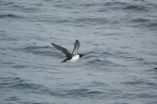(Press-News.org) CORVALLIS, Ore. – Marine resource managers often gauge the health of species based on overall biomass, but a new study of predator-prey relationships in the Bering Sea found that it isn't the total number of individuals that predators care about – it's how densely they are aggregated.
It's more than searching for an easy meal, the researchers say. Predators need to balance how much energy they expend in searching for food with the caloric and nutrient value of that which they consume. When prey doesn't aggregate, however, the search for food becomes much more difficult – affecting the health of the predators' offspring and the vitality of their overall population.
Results of the study were published this week in the journal PLOS ONE. The study was part of the Bering Sea Integrated Ecosystem Research Project, which was funded by the North Pacific Research Board and the National Science Foundation.
"We had to think very differently about these interactions, trying to see the world from the predators' point of view," said Kelly Benoit-Bird, an Oregon State University marine ecologist and lead author on the study. "When we first tried to identify good foraging locations for predator species we looked at areas of high prey numbers because it makes sense that they'd be where the food is. But the results didn't match what we might have expected.
"Predator populations that should have been doing well, based on prey numbers or biomass, were in fact not doing well," added Benoit-Bird, an associate professor in OSU's College of Earth, Ocean, and Atmospheric Sciences. "What we discovered is that smaller aggregations of prey are more attractive to predators if they are sufficiently dense."
The findings are particularly important, scientists say, because almost all fisheries management is based on biomass – tons of fish – and not how those fish may be distributed in the sea.
In their study, the researchers looked at the feeding behaviors of three co-occurring species in the Bering Sea, all of which consume juvenile pollock or krill – black-legged kittiwakes, thick-billed murres and northern fur seals. When they attempted to find a spatial relationship between these predators and the pollock using areal biomass and numerical abundance, they found little correlation.
However, when they began finding small patches of prey at certain depths and of sufficient density, the predators were there. And though the scientists know why – feeding efficiency – they aren't sure how.
"To be honest, we aren't really sure how these predators – which may travel many miles – locate the densest aggregations at depths well below the surface – and often at night," said Scott Heppell, a fisheries ecologist at Oregon State University and co-author on the PLOS ONE paper. "You wouldn't think murres and fur seals would have that much in common, but in this case they do."
"In a way, they're looking for the same thing that commercial fishing fleets look for – high-quality prey in aggregations dense enough to be economical," added Heppell, an assistant professor of fisheries and wildlife at OSU.
Benoit-Bird likened the predator-prey link to locating a box of popcorn in a darkened movie theater. You may have to search for it, she noted, but if you find the popcorn box, the payoff will be much more significant than what you might get by stumbling upon individual kernels in the dark that are spread throughout the theater – even though the number of kernels is the same.
That payoff is particularly meaningful for nurturing young, the researchers point out. During their two-year study, the research group tagged and observed female fur seals from St. Paul Island and Bogoslof Island as they swam hundreds of kilometers over a period of 1-2 weeks to gorge on nutrient-rich pollock then return to their homes to nurse pups.
They also tagged and observed adult murres and kittiwakes at St. Paul, St. George and Bogoslof Islands. The birds would capture local prey to feed their chicks during the day, but make numerous long flights at night to gorge on energy-rich, deep-water prey before returning to their nests to feed their chicks.
"It is a trade-off strategy," said Benoit-Bird, a 2010 recipient of a MacArthur Fellowship. "They feed themselves in one place and nourish their offspring from another."
This concept of prey "patchiness" can change rapidly, the researchers noted. Pollock aggregated only when the number of individuals in an area reached a certain threshold; below that threshold, they swam as individuals.
"If the population is sufficiently diffuse, the pollock don't aggregate and that could spell trouble for species that prey upon them," Heppell said. "A 10 percent shift in the number of fish could change how the entire stock behaves – and have a major impact on the birds, seals and other predators."
INFORMATION:
Other authors on the PLOS ONE paper include Brian Battaile, Chad Nordstrom and Andrew Trites of the University of British Columbia; Brian Hoover and Nathan Jones, University of California's Moss Landing Marine Laboratories; David Irons and Kathy Kuletz of the U.S. Fish and Wildlife Service in Anchorage; and Rosana Paredes, Robert Suryan and Chad Waluk of Oregon State University.
Bering Sea study finds prey density more important to predators than biomass
2013-01-04
ELSE PRESS RELEASES FROM THIS DATE:
Researchers: Online science news needs careful study
2013-01-04
MADISON — A science-inclined audience and wide array of communications tools make the Internet an excellent opportunity for scientists hoping to share their research with the world. But that opportunity is fraught with unintended consequences, according to a pair of University of Wisconsin–Madison life sciences communication professors.
Dominique Brossard and Dietram Scheufele, writing in a Perspectives piece for the journal Science, encourage scientists to join an effort to make sure the public receives full, accurate and unbiased information on science and technology.
"This ...
Mayo Clinic researchers find new molecule to target in pancreatic cancer treatment
2013-01-04
JACKSONVILLE, Fla. — Researchers at Mayo Clinic in Florida have identified a new target to improve treatment of pancreatic ductal adenocarcinoma cancer, which accounts for more than 95 percent of pancreatic cancer cases. This fast-growing, often lethal cancer is resistant to conventional chemotherapy. The findings are published in the Jan. 3 online issue of PLOS ONE.
The researchers decoded a molecular pathway that is switched "on" at all times, promoting accelerated growth of pancreatic tumors, and that discovery revealed ways to disable the pathway. They say one strategy ...
Editing the genome with high precision
2013-01-04
CAMBRIDGE, MA -- Researchers at MIT, the Broad Institute and Rockefeller University have developed a new technique for precisely altering the genomes of living cells by adding or deleting genes. The researchers say the technology could offer an easy-to-use, less-expensive way to engineer organisms that produce biofuels; to design animal models to study human disease; and to develop new therapies, among other potential applications.
To create their new genome-editing technique, the researchers modified a set of bacterial proteins that normally defend against viral invaders. ...
An embryo that is neither male nor female
2013-01-04
So, is it a girl or a boy? This is the first question parents ask at the birth of an infant. Though the answer is obvious, the mechanism of sex determination is much less so. Researchers at the University of Geneva (UNIGE) attempt to shed light on this complex process by identifying the crucial role played by insulin and IGF1 and IGF2 growth factors, a family of hormones known for its role in metabolism and growth. In the absence of these factors at the time of sex determination, embryos do not differentiate into either male or female and have no adrenal glands. The results ...
Turning smartphones into secure and versatile keys
2013-01-04
Smartphones and tablets have become an integral part of our daily lives. The capabilities of these handily sized mini-computers seem almost boundless as we phone friends, shoot holiday snaps, lose ourselves in a new music download or access the internet to obtain the boarding card for our next fl ight in comfort. Does it not seem logical, then, that we should make use of these constant companions as the key to our cars, front doors or lockers as well? A few such solutions are already available, but what's still missing is widespread market acceptance. At this year's CeBIT ...
Scientists discover how deadly skin cancer spreads into other parts of the body
2013-01-04
After recently announcing success in eliminating melanoma metastasis in laboratory experiments, scientists at Virginia Commonwealth University Massey Cancer Center have made another important discovery in understanding the process by which the gene mda-9/syntenin contributes to metastasis in melanoma (the spread of skin cancer) and possibly a variety of other cancers.
Published in the journal Cancer Research, the study demonstrated that mda-9/syntenin is a key regulator of angiogenesis, the process responsible for the formation of new blood vessels in tumors. Mda-9/syntenin ...
Liquid jets and bouncing balls combine for surprising results
2013-01-04
A new study published in the American Institute of Physics' (AIP) journal Physics of Fluids reveals that the normal rebounding of a ball changes when it is partially filled with a liquid. Unlike an empty sphere or a solid rubber ball, which both rebound in a classical and well-understood fashion, a fluid-filled ball has its second bounce remarkably cut short. A team of researchers from Brigham Young University in Provo, Utah, uncovered this phenomenon when they investigated what would happen if a sphere were partially filled with a liquid and how that would affect the way ...
Power spintronics: Producing AC voltages by manipulating magnetic fields
2013-01-04
Scientists are putting a new spin on their approach to generating electrical current by harnessing a recently identified electromotive force known as spinmotive force, which is related to the field of spintronics that addresses such challenges as improving data storage in computers. Now, a novel application of spintronics is the highly efficient and direct conversion of magnetic energy to electric voltage by using magnetic nanostructures and manipulating the dynamics of magnetization. According to a report published in the American Institute of Physics' (AIP) journal Applied ...
UC Davis study links low wages with hypertension, especially for women and younger workers
2013-01-04
(SACRAMENTO, Calif.) — Workers earning the lowest wages have a higher risk of hypertension than workers with the highest wages, according to new research from UC Davis.
The correlation between wages and hypertension was especially strong among women and persons between the ages of 25 to 44.
"We were surprised that low wages were such a strong risk factor for two populations not typically associated with hypertension, which is more often linked with being older and male," said J. Paul Leigh, senior author of the study and professor of public health sciences at UC Davis. ...
Sorting stem cells
2013-01-04
When an embryonic stem cell is in the first stage of its development it has the potential to grow into any type of cell in the body, a state scientists call undifferentiated. A team of researchers from Scotland has now demonstrated a way to easily distinguish undifferentiated embryonic stem cells from later-stage stem cells whose fate is sealed. The results are published in the American Institute of Physics' (AIP) journal Biomicrofluidics. The researchers used an electric field to pull stem cells through a fluid in a process called dielectrophoresis. They varied the frequency ...


